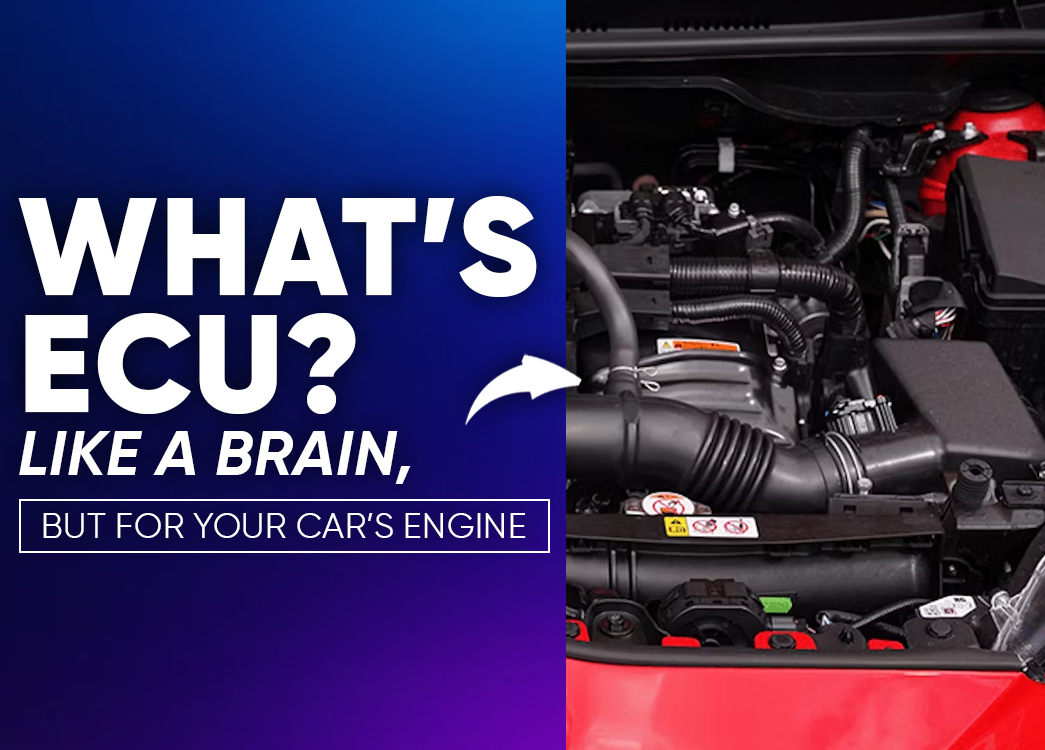
By creckk On 30-07-2025 at 11:43 am
ECU in Your Car: The Brain Behind the Smooth Ride
What is an ECU in Your Car?
Ever wondered what makes a modern car feel so responsive? The ECU, or Engine Control Unit, is the tech that makes it all happen. Acting as the vehicle’s command center, this powerful little unit takes care of everything from optimizing fuel efficiency to boosting engine performance. Today’s cars can have 30-50 ECUs managing different parts of the vehicle. But, it’s the ECU that plays the most crucial role in making sure everything runs like a well-oiled machine.
What Does the ECU Do?
The ECU’s job is to manage a variety of engine functions, all to ensure your car runs smoothly. Here’s what it controls:
- Fuel Injection: It adjusts how much fuel goes into the engine for optimal power and efficiency.
- Spark Timing: It decides when to fire the spark plugs, keeping the engine’s rhythm in check.
- Idle Speed: When your car is at rest, the ECU manages how fast the engine should idle.
- Air-Fuel Ratio: Ensures the engine is getting the right balance of air and fuel for efficient combustion.
- Emission Controls: Helps reduce harmful emissions by managing exhaust and fuel systems.
- Turbo Boost (for turbocharged cars): Optimizes the turbo system for more power when you need it.
How Does the ECU Work?
It’s like a super-fast, super-smart brain that works behind the scenes. Here’s how it functions:
- Data Collection: Sensors around the car send info to the ECU, such as engine temperature, air pressure, and oxygen levels.
- Processing: The ECU analyzes this data in real-time and uses pre-programmed maps to decide what adjustments need to be made.
- Action: The ECU sends signals to components like fuel injectors or ignition coils to make changes adjusting the engine for peak performance.
Types of ECUs in Modern Cars
ECUs are everywhere in today’s vehicles, and each one is responsible for a different function. Here are some of the key ECUs that modern cars rely on:
- Engine Control Unit (ECU): Manages engine performance like fuel injection and ignition timing.
- Transmission Control Module (TCM): Handles automatic gear shifts for smooth driving and improved fuel economy.
- Body Control Module (BCM): Controls non-engine functions like central locking, power windows, and interior lighting.
- Anti-lock Braking System (ABS) Control Module: Prevents wheel lock-ups during hard braking for better control.
- Airbag Control Module (ACM): Deploys airbags in the event of a crash and ensures optimal safety.
- Fuel Injection Control Module (FICM): Regulates fuel delivery for efficient combustion in diesel engines.
- Electronic Stability Control (ESC) Module: Ensures vehicle stability on slippery roads by adjusting engine power and braking individual wheels.
- Adaptive Cruise Control (ACC) Module: Uses sensors and radar to adjust your speed and keep a safe distance from vehicles ahead.
- Battery Management System (BMS): Controls battery health and charging for electric and hybrid cars.
- Climate Control Module (CCM): Manages the HVAC system for optimal cabin temperature.
ECU Fault Codes: The Warning Signs
When something’s wrong, the ECU has a way of telling you: Fault Codes. These codes are your car’s way of raising the alarm, letting you know which system is malfunctioning. It’s like having a personal mechanic onboard who always keeps an eye out for issues.
When your Check Engine light comes on, it’s the ECU’s way of telling you to pay attention. Fault codes are part of your car’s On-Board Diagnostics (OBD-II) system, which helps technicians pinpoint the issue quickly.
What Do ECU Fault Codes Look Like?
Fault codes are typically a mix of letters and numbers, like P0301 or P0420. Here’s a breakdown of how to read them:
- First Letter: It tells you which system is involved:
- P = Powertrain (engine, transmission, fuel system)
- B = Body (airbags, lights, climate control)
- C = Chassis (brakes, steering, suspension)
- U = Network (communication between ECUs)
- First Number: This digit tells you if the fault is a standard code or specific to a manufacturer:
- 0 = Standard code
- 1 = Manufacturer-specific code
- Second Number: Indicates the system involved:
- 1 = Fuel/air metering
- 2 = Fuel injector circuit failure
- 3 = Ignition or misfire
- 4 = Emissions control
- 5 = Speed control or idling issues
- 6 = Computer issues
- 7/8 = Transmission problems
- Last Two Digits: These digits define the specific issue. For example, P0302 refers to a misfire in cylinder 2.
Why Are ECU Fault Codes So Important?
These codes save time and money. Instead of guessing, the mechanic can quickly identify the issue and fix it fast. Modern garages can read these codes in seconds with an OBD-II scanner. You can even buy a personal scanner to read them yourself!
What Happens if the ECU Fails?
A faulty ECU can cause chaos. The signs of an ECU failure include:
- Poor engine performance
- The car won’t start
- Increased fuel consumption
- Persistent engine warning light
- Engine stalling or jerking
The Role of the ECU in Electric & Hybrid Cars
In electric and hybrid vehicles, ECUs play an even bigger role. They manage the battery, electric motor, energy regeneration, and climate control systems, making these cars incredibly efficient and smooth to drive.
How to Keep Your ECU Healthy
Keep your car’s ECU in good shape with these tips:
- Avoid jump-starting the car incorrectly (it can damage the ECU).
- Keep your battery in top condition.
- Don’t drive through deep puddles (it can damage the ECU, which is often mounted near the engine).
- Use high-quality fuel to avoid dirty sensors.
- Schedule regular maintenance to keep everything in check.
Final Thoughts
The ECU is the unsung hero of modern vehicles, keeping everything running smoothly and efficiently. It ensures you’re driving at your best whether it’s optimizing performance, reducing emissions, or keeping you safe. Next time you hit the road, remember that the ECU is working behind the scenes, making your drive that much smarter.
FAQs:
1. What is the full form of ECU?
ECU stands for Engine Control Unit or Electronic Control Unit, which is responsible for managing engine functions and other critical systems in your car.
2. Can a car run without an ECU?
No, the ECU is crucial for engine performance. Without it, modern cars cannot function properly.
3. How can I tell if my ECU is failing?
Look out for signs like poor engine performance, excessive fuel consumption, stalling, or the Check Engine light turning on.
4. Can the ECU be repaired, or does it need to be replaced?
It depends. If the ECU is damaged, it might be repaired. However, severe issues may require a replacement.
Related posts









